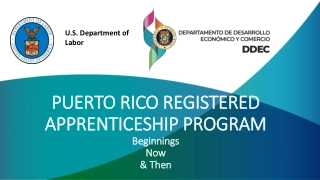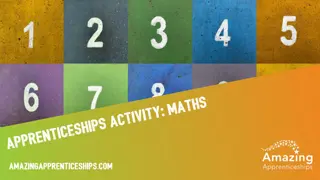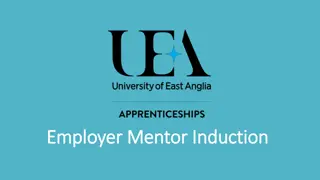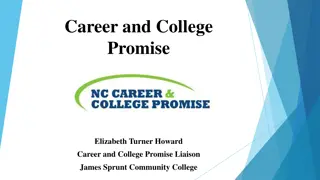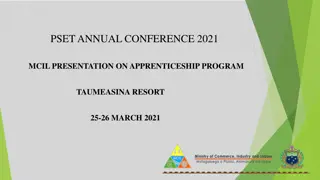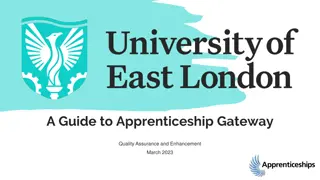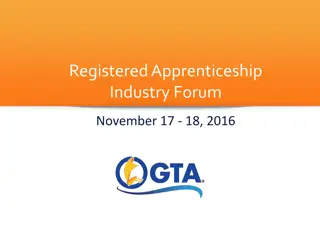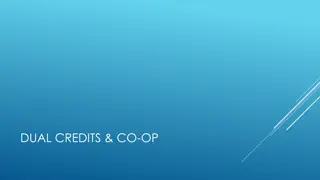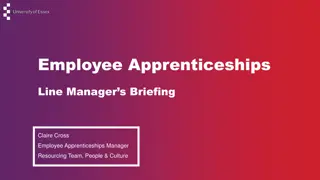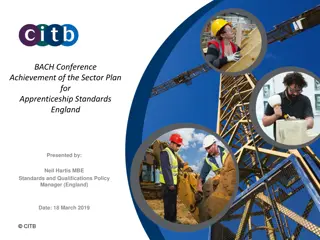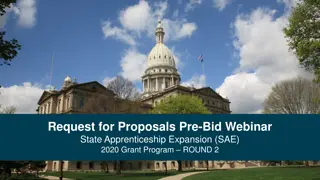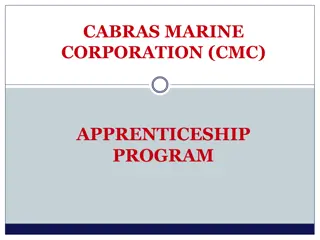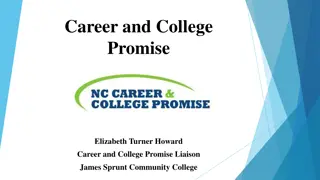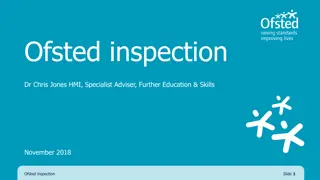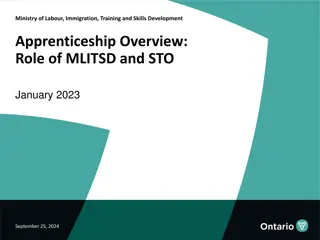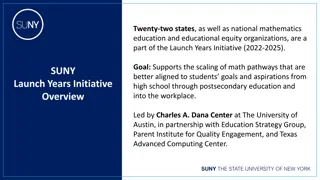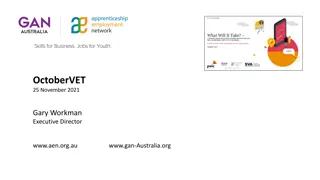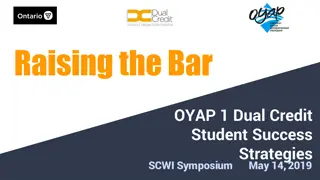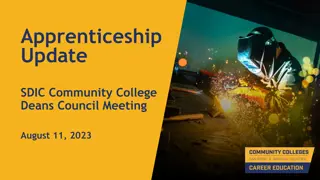Supporting Students in Apprenticeship Pathways: Strategies for Success
Explore the School-College-Work Initiative (SCWI) and its contributions to enhancing student transitions from secondary to postsecondary education through collaborative programs. Learn about supporting students interested in apprenticeship pathways and strategies for successful postsecondary steps towards apprenticeship completion. Discover resources and opportunities for guiding students on the path to career success.
Download Presentation

Please find below an Image/Link to download the presentation.
The content on the website is provided AS IS for your information and personal use only. It may not be sold, licensed, or shared on other websites without obtaining consent from the author.If you encounter any issues during the download, it is possible that the publisher has removed the file from their server.
You are allowed to download the files provided on this website for personal or commercial use, subject to the condition that they are used lawfully. All files are the property of their respective owners.
The content on the website is provided AS IS for your information and personal use only. It may not be sold, licensed, or shared on other websites without obtaining consent from the author.
E N D
Presentation Transcript
Tuesday, September 29, 2020 1:30pm 2:30pm
Agenda Agenda 1. Welcome and Introductions 2. Setting Up Students for Success 3. Invitation to Propose Pilots 4. Guest Speakers 5. Supplementary Reporting 6. Resources 7. Student Decision-Making 8. Questions, Comments, Discussion 9. Next Steps 10. Closing Comments 2 SCWI/IJECT
School School- -College College- -Work Initiative (SCWI) Work Initiative (SCWI) Since its inception in 1997, the SCWI has contributed to the goal of increasing the number of students who graduate from secondary school and providing a seamless transition from secondary school to postsecondary education by supporting collaborative activities and programs.
Supporting Students Interested in Supporting Students Interested in Apprenticeship Pathways Apprenticeship Pathways Ministries focus on trades MLTSD consultations, surveys 4 SCWI/IJECT
Supporting Students Interested in Supporting Students Interested in Apprenticeship Pathways Apprenticeship Pathways Matching students with appropriate opportunities, one student at a time, is an effective strategy in support of student success. Pathways to Apprenticeship: Options for Secondary School Students, p.4 (http://www.edu.gov.on.ca/eng/teachers/studentsuccess/PathwayApprentice.pdf ) 5 SCWI/IJECT
Supporting Students Interested in Supporting Students Interested in Apprenticeship Pathways Apprenticeship Pathways Level 1 Dual Credit Students Postsecondary Steps towards Apprenticeship Completion After graduating from high school, students must notify the local Employment Ontario apprenticeship office of their graduation, and of whether the placement with the employer (sponsor) is continuing. Students must also notify the local Employment Ontario office if their employer (sponsor) changes. Pathways to Apprenticeship: Options for Secondary School Students, p.25 (http://www.edu.gov.on.ca/eng/teachers/studentsuccess/PathwayApprentice.pdf ) 6 SCWI/IJECT
www.ontario.ca/page/start- apprenticeship 7 SCWI/IJECT
https://www.eoss.tcu.gov.on.ca/AOL/ training/prerequirements 8 SCWI/IJECT
Supporting Students Interested in Supporting Students Interested in Apprenticeship Pathways Apprenticeship Pathways - - Pilot Pilot Supporting committed students to continue on their chosen path In addition to current supports dual credit teacher, co-op teacher, OYAP coordinator, Guidance Counsellor, the college supports There may be a disconnect from their schools and those available supports because they are not at school (co-op and Level 1 in-school training) 9 SCWI/IJECT
SCWI Invitation to Propose Pilot SCWI Invitation to Propose Pilot Last year, RPTs had the opportunity to pilot transition supports for Level 1 dual credit students. Given the interest following the presentation on Lambton College s 2019-20 pilot at the November 3, Level 1 Apprenticeship Dual Credit Update Webinar* SCWI is extending this pilot for 2020-21. Pilot transition supports for Level 1 dual credit students will be in addition to what is currently in place in boards and colleges. This would provide an opportunity to better understand if/why students don t continue with another Registered Training Agreement after secondary school, or the barriers to students continuing to Level 2. *Recording and accompanying Power Point presentation available in the Level 1 Apprenticeship Update Webinars section: http://scwi.ca/scwi/research.php / 10 SCWI/IJECT
After SWAC and After ADC After SWAC and After ADC Includes four components: 3 one-hour group conversations per class with a college advisor and dual credit teacher, if appropriate ($45/hour) eight hours of PD and reporting for the college advisor and dual credit teacher (per class) 4 hours of one-on-one follow-up conversations per student with the college advisor Miscellaneous ($20/student) Funded OCAS/OUAC applications for ADC/SWAC students 11 SCWI / IJECT
Funding for Pilots Funding for Pilots Recommended costing these pilots similar to After SWAC/After ADC SCWI likely needs to figure out how to fund this if the pilots continue 12 SCWI/IJECT
Guest Speakers Guest Speakers Tracy Norris Academic Manager (Acting), Academic Partnerships & CE Media & Design Algonquin College Candace Carson School to Work Transitions Consultant 13 SCWI/IJECT
14 SCWI/IJECT
Guest Speakers Guest Speakers Greg Sheeler OYAP Student Advisor Lambton College 15 SCWI/IJECT
Supplementary Reporting Supplementary Reporting 3a. Please identify barriers to students in continuing their apprenticeship. 3b. Please identify any strategies you have considered or implemented to help students overcome these barriers: 4. Who were the important contacts (individuals or organizations) you made in order to support your students? 5. Please describe 2-3 strengths of this pilot. 6. Are there changes you would implement if you repeated this pilot? If so, please describe briefly. 16 SCWI/IJECT
Resources 17 SCWI/IJECT
IN-DEMAND Skilled Trades Research Project 2019 Waterloo, Wellington and Dufferin Counties Presented by: Carol Simpson Project Researcher & former Executive Director Workforce Planning Board of Waterloo Wellington Dufferin List of all LTABS: http://www.workforceplanningontario.ca/en/
Now that they are graduating from secondary Now that they are graduating from secondary school, and before they leave school, and before they leave Exit interview/a conversation around their first post-secondary step towards becoming a journey person Does the student know which trade they are interested in, have an employer, have a plan for finding an employer? What else does the student need? What gaps are there in their knowledge? What can you do to help? Who else can help them? Job-shadowing, informational interviews, employers, employees, professional organizations, trade unions Invitation to come back for help in the future? The risk of not having conversations is that these students will get stuck. 19 SCWI/IJECT
Student Decision Making Student Decision Making A look at UCAS 2020: The marketing initiatives that matter Academica Forum In our previous article, we examined the reasons for attending postsecondary education. Today, we ll be looking at the information and resources students used to research postsecondary institutions and guide their decision-making process. Where students seek information In 2020, the most common source of information for both university and college students was institution websites, followed by viewbooks, emails, and/or conversations with current students. Some resources were more commonly used by university students, while others were preferred by college students. 20 SCWI/IJECT
Dream Adjusters: High School Counselors in a Dream Adjusters: High School Counselors in a Low Low- -Income School District Income School District some students are likely to become heavy users, whereas others receive little, if any, individualized advising. Self-selection may direct services to those who recognize their value, whereas other quietly needy students go unserved. (https://journals.sagepub.com/doi/abs/10.1177/0013124519887712) 21 DRAFT
Next Steps 22 SCWI/IJECT
Questions, Comments, Discussion 23 SCWI/IJECT
Closing Comments 24 SCWI/IJECT
Contact Us Contact Us David Armstrong DavidArmstrong@ontariodirectors.ca Janine Griffore Janine.Griffore@gmail.com Phil Hedges PhilHedges@kwic.com Sonja Vandermeer SVandermeer@ontariodirectors.ca 25 SCWI/IJECT


